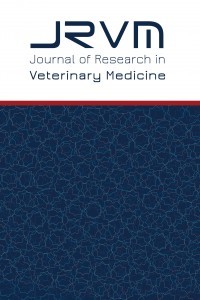Yağlı Diyetle Beslenen Farelerin Karaciğer Dokusunda Magnezyumun Nitrik Oksit, Malondialdehit ve Glutatyon Düzeylerine Etkisi
The effect of Magnesium on Nitric Oxide, Malondialdehyde and Glutathione in Mice Liver Tissue Fed on Fat-Diet
___
- Altunkaynak Z. Effects of high fat diet induced obesity on female rat livers (a histochemical study). Eur J Gen Med, (2005). 2(3): 100-109.
- Beutler, E.. Duron, O.. Kelly, B.M. Improved method for determination of blood glutathione. J. Lab. Clin Med. (1963). 61: 882-888.
- Capel ID, Dorrell HM. Abnormal antioxidant defense in some tissues of congenitally obese mi-ce. Biochem J. (1994).,219: 41- 49, 14.
- Choi JW, Pai SH, Kim SK, Ito M, Park CS, Cha YN. Increases in nitric oxide concentrations cor-relate strongly with body fat in obese humans. Clin Chem. (2001). 47(6):1106-9.
- Cristol JP, Maggi MF, Guérin MC, Torreilles J, Descomps B. Nitric oxide and lipid peroxidation. C R Seances Soc Biol Fil, (1995). 189:797-809.
- Davì G, Guagnano MT, Ciabattoni G, Basili S, Falco A, Marinopiccoli M, Nutini M, Sensi S, Patrono C. Platelet activation in obese women: role of inflammation and oxidant stress. JAMA. (2002). 23-30, 288(16): 2008-14.
- Elizalde M, Rydén M, van Harmelen V, Eneroth P, Gyllenhammar H, Holm C, Ramel S, Olund A, Arner P, Andersson K. Expression of nitric oxide synthases in subcutaneous adipose tissue of no-nobese and obese humans. J Lipid Res (2000). 41: 1244-51.
- Fearon IM, Faux SP. Oxidative stress and cardio-vascular disease: novel tools give (free) radical insight. J Mol Cell Cardiol; (2009). 47: 372-81.
- Galic S, Oakhill JS, Steinberg GR. Adipose tis-sue as an endocrine organ. Mol Cell Endocrinol, (2010). 316: 129-39.
- Ghosh S, Sulistyoningrum C.D, Glier B.M, Verchere B.C, Devlin M.A. Altered glutathione homeostasis in heart augments cardiac lipo-toxicity associated with diet-induced obesity in mice. J Biolog Chem, (2011). 42483-42493.
- Guerre-Millo M. Adipose tissue and adipokines: for better or worse. Diabetes Met. (2004). 30: 13-9.
- Günyaktı A. Katı ve sıvı yağ tüketiminin karaci-ğerde glutatyon sentezi ve serbest radikal üretimi üzerine olan etkilerinin araştırılması, Yüksek Li-sans Tezi, Selçuk Üniv Biyokimya (Tıp) AD, Konya. (2000).
- Halliwell B, Gutteridge JMC. Free Radicals in Biology and Medicine, Third Edition, Oxford Science Publications, (2001). 22- 24.
- Higashi Y, Sasaki S, Nakagawa K, Kimura M, Noma K, Sasaki S. Low body mass index is a risk factor for impaired endothelium-dependent vasodilation in humans: Role of nitric oxide and oxidative stress. J Am Coll Cardiol. (2003). 42:256- 63.
- Higdon JV, Frei B. Obesity and oxidative stress: a direct link to CVD? Arterioscler Thromb Vasc Biol. (2003).23: 365-7.
- Huerta MG, Roemmich JN, Kington ML, Bov-bjerg VE, Wettman AL, Holmes YF, Magnesium deficiency is associated with insulin resistance in obese children: Diabetes Care (2005). 28:1175-81.
- Kershaw EE, Flier JS. Adipose tissue as an en-docrine organ. J Clin. Endocrinol Met., (2004). 89: 2548-56.
- Khan NI, Naz L, Yasmeen G. Obesity: an inde-pendent risk factor for systemic oxidative stress. Pak J Pharm Sci, (2006). 19: 62-5.
- Kharb S, Singh V. Magnesium deficiency poten-tiates free radical production associated with myocardial infarction. J Assoc Physicians India (2000). 48:484-5.
- Lee JS, Lee MK, Ha TY, Bok SH, Park HM, Jeong KS, Woo MN, Do M, Yeo JY, Choi MS. Supplementation of whole persimmon leaf imp-roves lipid profiles and suppresses body weight gain in rats fed high-fat diet. Food Chem Toxicol, (2006). 44 (11): 1875-83.
- Matsubara M, Maruoka S, Katayose S. Inverse relationship between plasma adiponectin and lep-tin concentrations in normal-weight and obese women. Eur J Endocrinol, (2002). 147: 173-80.
- Miller, D.D. Minerals. In “Food Chemistry”, O.R. Fennema (Ed), pp: Marcel Dekker, New York. (1996). 617-649.
- Miranda KM., Espey MG., Wink DA., A rapid, simple spectrophotometric method for simultane-ous detection of nitrate and nitrite. Nitric Oxide., (2001).5, 62-71.
- Olszanecka-Glinianowicz M, Zahorska-Markiewicz B, Janowska J, Zurakowski A. Se-rum concentrations of nitric oxide, tumor necro-sis factor (TNF)-alpha and TNF soluble receptors in women with overweight and obesity. Met (2004). 53:1268-73.
- Özata, M, Mergenb M, Oktenli C, Aydin A, Sanisoglu SY, Bolu E, Yilmaz M.İ, Sayal A, Isi-mer Ozdemir C. Increased oxidative stress and hypozincemia in male obesity. Clin Biochem. (2002).35, 8, 627–631.
- Seyithanoğlu M., Öner-İyidoğan Y., Koçak H., Koçak-Toker N., Uysal M. Yüksek yağlı diyetle beslenen farelerin karaciğerinde trigliserid düzey-leri ve oksidatif stres üzerine enginar yaprağı ekstresinin etkisi. Tr J.Biochem, (2012). 37.
- Ryu MH, Cha YS. The effects of a high-fat or high-sucrose diet on serum lipid profiles, hepatic acyl-CoA synthetase, carnitine palmitoyltransfe-rase-I, and the acetyl-CoA carboxylase mRNA levels in rats. J Biochem Mol Biol, (2003). 36 (3): 312-318. 30
- Woods SC, D’alessıo DA, Tso P, Rushıng PA, Clegg DJ, Benoıt SC, Gotoh K, Lıu M, Seeley RJ. Consumption of a high-fat diet alters the ho-meostatic regulation of energy balance. Physiol Behavior, (2004). 83 (4): 573-578.
- Yoshioka T., Kawada K., Shimada T., Mori M., Lipid peroxidation in maternal and cord blood and protective mechanism against activatedoxy-gen toxicity in the blood. Am. J. Obstet. Gynecol, (1979).135, 372-376.
- Yilmaz A, Coban E, Sari R. The effect weight loss on the mean platelet volume in obese pati-ents. Platelets (2007). 18 (3): 212-216.
- Başlangıç: 1981
- Yayıncı: Bursa Uludağ Üniversitesi
Bir Buzağıda Vertebral Malformasyon ve Siringomiyeli
Hilal ÇEŞME, Volkan İPEK, Ahmet AKKOÇ, Hakan SALCI
Persiste Enfekte Buzağıların İnaktive Edilmiş Serumlarından Bovine Viral Diyare Virusu İzolasyonu
Pelin TUNCER-GÖKTUNA, Kadir YEŞILBAĞ
Bir Atta Blanket’e Bağlı Kuyruk Yaralanması Olgusu
Mustafa Barış AKGÜL, Erhan BAŞER, Ali GÜLAYDIN, Nihat ŞINDAK
Bir Buzağıda Salter-Harris Tip I Metacarpus Kırığının Açılı Kama Plağı İle Sağaltımı
Hakan SALCI, Uygur CANATAN, Melike ÇETİN
Bombus terrestris Sindirim Kanalının Bazı Bölge Mukozalarının Klasik ve Lektin Histokimyasal yapısı
Kıvırcık Irkı Bir Kuzuda Meningosel ve Unilateral Serebellar Hipoplazi
İsmail Altuğ ŞEN, Volkan İPEK, Aylin Alasonyalılar DEMİRER, Hakan SALCI
Yetiştirme Sistemleri ve Kabuk Renginin Bazı Yumurta Kalite Parametrelerine Etkisi
